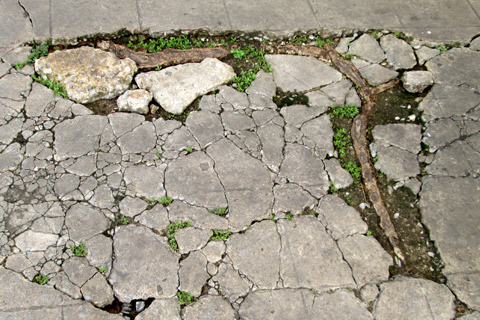
Tree roots constantly seek a water source, in doing so, they can spread very deep or very shallow and in a very large radius from the trunk. When roots spread at shallow depths, they will find their way under asphalt, sidewalks, and yes, driveways.
As the roots naturally expand and thicken, they will displace everything around them creating tremendous potential energy. This energy is usually released upward (path of least resistance), resulting in the breaking, cracking, warping, or buckling of whatever structure is above.
Here, we will discuss measures you can take to repair damaged concrete, remove damaging roots, and how to avoid this issue in the future.
The answer to this isn’t quite as simple as it may seem. Here are some factors to consider:
Tree Roots Three Inches or More in Diameter – When cutting roots this size, they typically will not grow back. However, a wound this large leaves the root susceptible to insect and disease. Often times, this allows rot to reach all the way back to the trunk, seriously compromising the health of the tree.
Tree Roots Less Than Two Inches in Diameter – Tree roots this size are typically able to regenerate. Removing them will only e a temporary fix.
Tree Roots Grow Far and Wide – Typically, you will find that one inch converts to about a foot and a half. That is, for every inch at DBH (Diameter at Breast Height – measured 4.5 feet above the ground), the roots will extend up to a foot and a half away from the tree trunk. A twelve inch trunk at DBH means roots are extending up to eighteen feet away from the trunk in every direction.
Tree Roots Are Sensitive to Disturbance – Tree roots seek out uncompacted soil rich in oxygen (like the soil under sidewalks and driveways). When the soil underneath a tree is compacted by heavy machinery or used as a storage area for a construction site, the roots beneath the surface are literally being choked to death. Eventually, this will result in the decline of the tree’s health, leading to its death.
Tree Roots Under the Driveway – Roots provide structural integrity to a tree. If they have grown under the driveway, the driveway is now a part of its structural integrity. Depending on the size and depth of the roots, removing them may lead to the falling of the tree in severe weather.
More often than not, by the time tree roots have buckled your driveway, you may be faced with the ultimate removal of the tree, if you are to break up and re-lay the affected portion of the driveway.
If the tree is a keeper in your landscape and the roots in question are vital to its survival, there are construction options or methods which will allow the coexistence of the roots and your driveway. Here is one of the multiple options you may use:
Aggregate Surfacing – This technique requires the cutting and careful removal of the damaged concrete. Once the concrete has been removed, the surface below is covered with driveway fabric (aka: geotextile fabric), then four to five inches of dense grade aggregate (DGA) or road stone. The project is completed by using edging along the sides to prevent the aggregate from spreading laterally.
Ultimately, it is the lack of planning or the proper information to form a plan that lead to situations such as these. Before planting a tree, you should be aware of its species, potential growth, root spread capacity, and if its roots are typically classified as invasive or not.
Location is a key factor in the survival of any tree or plant. Planting a tree too close to a structure is like inviting a bull into a china cabinet. As trees grow, they instinctively seek out water sources, expand their canopies, and potentially wreak havoc on the structure they were planted next to.
Once a tree is planted, frequent watering will help its root system to grow deeper. Shallow root systems often reflect insufficient watering or compacted soil further beneath the surface.
To learn more about proper planting, see: http://treecareadvice.blogspot.com/2015/12/properly-planting-canadian-hemlock.html
While the solution you choose may be an easy one, innocent mistakes may lead to a much more serious situation as your tree’s health declines and ultimately dies.
Before any steps are taken to remove a tree or a portion of its root system, it is highly recommended to seek the advice of a certified arborist. An arborist is a tree professional trained to spot trouble pertaining to tree issues and how to efficiently resolve them.